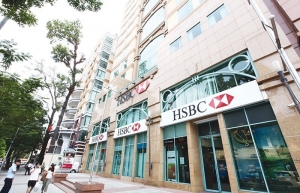Banks to soon complete Basel III international standards
Orient Commercial Joint Stock Bank (OCB) recently said it was focusing on implementing higher international standards of Basel III and expected to complete it by the end of this year. Previously, OCB was one of the banks that completed the application of Basel II standards on capital adequacy according to the State Bank of Viet Nam (SBV)’s Circular 41/2016/TT-NHNN in December 2018, just after Viet Nam International Commercial Joint Stock Bank (VIB) and Commercial Joint Stock Bank for Foreign Trade of Viet Nam (Vietcombank).
 |
| A transaction office of Orient Commercial Joint Stock Bank (OCB) in Ha Noi. OCB is focusing on implementing higher international standards of Basel III and expects to complete by the end of this year.-VNA/VNS Photo |
In May 2022, Southeast Asia Commercial Joint Stock Bank (SeABank) also announced the results of the application of Basel III standards to the bank’s operations as well as risk management.
Previously, some banks began to carry out Basel III immediately after their completion of Basel II. For example, Tien Phong Commercial Joint Stock Bank (TPBank) announced it completed all the requirements of Basel III at the end of 2021.
On February 2022, Nam A Commercial Joint Stock Bank (NamABank) also announced it would carry out and apply the risk management requirements under Basel III. This move was made after the bank was recognised to comply with all Basel II standards.
VIB and Maritime Commercial Joint Stock Bank (MSB) have completed the application of Basel III in liquidity management, operational risk management, and market risk management.
Meanwhile, HCM City Development Commercial Joint Stock Bank (HDBank) has applied two liquidity ratios including the net stable funding ratio (NSFR) and liquidity coverage ratio (LCR) of Basel III standards.
Compliance with Basel standards is very important to banks in the current context when the SBV will give priority to higher credit growth quota for banks with abundant equity, high capital adequacy ratio (CAR) and good risk management through the application of Basel II, Basel III and international financial reporting standards 9 (IFRS 9).
In addition, the application of Basel III also helps banks improve their credit rating and enhance their competitiveness in the international market.
Basel III is the third Basel Accord, a framework that sets international standards for bank capital adequacy, stress testing, and liquidity requirements. Augmenting and superseding parts of the Basel II standards, it was developed in response to the deficiencies in financial regulation revealed by the financial crisis of 2007-08. It is intended to strengthen bank capital requirements by increasing minimum capital requirements, holdings of high quality liquid assets, and decreasing bank leverage.
Basel III was published by the Basel Committee on Banking Supervision in November 2010, and was scheduled to be introduced from 2013 until 2015; however, implementation was extended repeatedly to January 1, 2022 and then again until January 1, 2023, in the wake of the COVID-19 pandemic.
 | Banks raise charter capital for new growth stage A slew of local and foreign banks are increasing charter capital to prepare for the new growth phase of the banking industry and the economy. |
 | HDBank's profit before tax exceeds $240 million HDBank's profit before tax for the first half of the year exceeded $240 million, fulfilling 54 per cent of its annual budget. Its separate non-performing loan (NPL) ratio was only 0.93 per cent. |
 | Banks should tighten assessment control of their corporate bonds investments: experts Banks must tighten their assessment control of corporate bond investments to avoid excessive risk and the misuse of funds raised by firms, experts said. |
 | Banks acknowledge women’s changing role in business Financial institutions are looking to bridge the gender gap, with women all across the globe facing financial discrimination and suffering from less access to capital than their male counterparts. |
What the stars mean:
★ Poor ★ ★ Promising ★★★ Good ★★★★ Very good ★★★★★ Exceptional
Related Contents
Latest News
More News
- Tax sector wraps up 2025 and sets priorities for next year (December 25, 2025 | 14:00)
- A tipping point for digital and hybrid wealth management in Vietnam (December 23, 2025 | 13:33)
- $250 million deal targets women-owned SMEs, sustainable agriculture (December 22, 2025 | 17:40)
- Stock market posts resilient 2025 performance (December 19, 2025 | 18:17)
- Citi Vietnam receives 2025 AmCham CSR recognition (December 19, 2025 | 16:35)
- As global green supply chain reshapes, will Vietnam be left behind? (December 19, 2025 | 08:00)
- Banks gear up for massive capital increases (December 18, 2025 | 17:04)
- Securing capital and efficiency for Vietnam’s 2026-2030 growth ambitions (December 17, 2025 | 10:00)
- Energy sector in need of blended finance mechanisms (December 17, 2025 | 09:00)
- Vietnam still has room to mobilise capital for sustainable growth (December 17, 2025 | 08:57)

 Tag:
Tag:




















 Mobile Version
Mobile Version